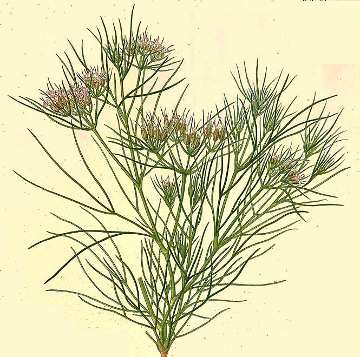 Cuminum cyminum
Cuminum cyminumCumin
An anti-theft herb in Italy and Germany, where it was considered that a thief (human or otherwise) would not be able to steal the family's bread if it contained some cumin seeds. Also in Italy, cumin was mixed with wine or bread and fed to a lover to ensure faithfulness or given to homing pigeons so they would return home, so the idea of fixing someone in place seems pretty important with this magic herb. Cumin was traditionally burned to repel the evil eye, in which case, consider mixing it 1:4 cumin:olibanum. To help prevent theft, mix a pinch of cumin with frankincense, juniper berries, and vetiver and cense the perimeter of the house and its openings. In ancient times, a mixture of cumin, carob, and frankincense was part of a charm bag containing silver talismans with holy names on them. Oddly enough, in the Eber papyrus of ancient Egypt, the cumin/carob/frankincense is described as a medicinal powder for driving out the bad influence or energy that causes disease. Cumin is also a component in a house blessing incense when ground 1:1 with bay leaf. In contrast to its use in fixing in place, cumin is mentioned as an ingredient (along with grated orange peel, salt, pepper and rue) in a philtre to cause lovers to quarrel in Paul Huson's "Mastering Witchcraft." Either way, this is a handy spice for the witch's cabinet. Top
Mundane Uses
A beloved funkiness since ancient times, cumin is great to add to incense or
scented oils to introduce a vegetal musk note, but a little goes
a long way. A good warming digestive, cumin was a favorite culinary
spice of Rome and Greece and still important in cooking in India
and Mexico. Cumin was important enough in the past that it was buried
with the dead in ancient Egypt so their food would have good flavor
in the afterlife. Top
How to Grow Cumin
Soak seeds for 8 hours before sowing. Germinates in 7-14 days at room temperature.
Transplant to full sun or direct sow outside about 2 weeks after
last frost. In that case, the soil needs to be light because the
seedlings are not able to break through heavy soil. You can always
sow and then cover lightly with clean (not beach) sand. Looks
like dill but is much shorter--6-12"/15-30cm tall. Plant 3-6"/7-15cm
apart. This annual tends to self-sow if it has a growing season
of 100-120 days. It won't ripen in very cold climates because the
season is not long enough, which gave it the reputation of being
a "stingy" plant (and the word "cumin" was applied
to Roman misers). Let pods dry on the plant and then harvest
by breaking them open. Grows best in Meditterranean climates (warm
and dry, NOT hot--in the Middle East, for instance, it is started
in fall and harvested in early spring).
General
growing info Top
Cuminum cyminum
Cumin
100 seeds $3.50
Uses in Witchcraft & Magic:
Fixing in place
Love Spells
Aries
Herb
Mars/Fire Herb
© 2015-2024 Alchemy Works; No reproduction without permission